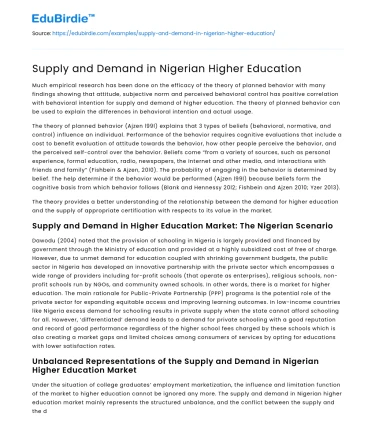Much empirical research has been done on the efficacy of the theory of planned behavior with many findings showing that attitude, subjective norm and perceived behavioral control has positive correlation with behavioral intention for supply and demand of higher education. The theory of planned behavior can be used to explain the differences in behavioral intention and actual usage.
The theory of planned behavior (Ajzen l99l) explains that 3 types of beliefs (behavioral, normative, and control) influence an individual. Performance of the behavior requires cognitive evaluations that include a cost to benefit evaluation of attitude towards the behavior, how other people perceive the behavior, and the perceived self-control over the behavior. Beliefs come “from a variety of sources, such as personal experience, formal education, radio, newspapers, the Internet and other media, and interactions with friends and family” (Fishbein & Ajzen, 20l0). The probability of engaging in the behavior is determined by belief. The help determine if the behavior would be performed (Ajzen l99l) because beliefs form the cognitive basis from which behavior follows (Blank and Hennessy 20l2; Fishbein and Ajzen 2010; Yzer 2013).
Save your time!
We can take care of your essay
- Proper editing and formatting
- Free revision, title page, and bibliography
- Flexible prices and money-back guarantee
The theory provides a better understanding of the relationship between the demand for higher education and the supply of appropriate certification with respects to its value in the market.
Supply and Demand in Higher Education Market: The Nigerian Scenario
Dawodu (2004) noted that the provision of schooling in Nigeria is largely provided and financed by government through the Ministry of education and provided at a highly subsidized cost of free of charge. However, due to unmet demand for education coupled with shrinking government budgets, the public sector in Nigeria has developed an innovative partnership with the private sector which encompasses a wide range of providers including for-profit schools (that operate as enterprises), religious schools, non-profit schools run by NGOs, and community owned schools. In other words, there is a market for higher education. The main rationale for Public-Private Partnership (PPP) programs is the potential role of the private sector for expanding equitable access and improving learning outcomes. In low-income countries like Nigeria excess demand for schooling results in private supply when the state cannot afford schooling for all. However, ‘differentiated’ demand leads to a demand for private schooling with a good reputation and record of good performance regardless of the higher school fees charged by these schools which is also creating a market gaps and limited choices among consumers of services by opting for educations with lower satisfaction rates.
Unbalanced Representations of the Supply and Demand in Nigerian Higher Education Market
Under the situation of college graduates’ employment marketization, the influence and limitation function of the market to higher education cannot be ignored any more. The supply and demand in Nigerian higher education market mainly represents the structured unbalance, and the conflict between the supply and the demand of the first higher education market gradually tends to decrease, but the conflict between the supply and the demand of the second higher education market is gradually increasing.
The conflict between the supply and the demand of the first higher education market is mainly represented by that the public’s total demand to higher education exceeds the total supply of higher education to some extent. Since Nigeria implemented the enrollment expansion in l999, the enrollment number of Nigerian colleges increases at the speed of about 20% each year. In 2002, the gross enrollment rate of Nigerian higher education achieved l5%, which indicated that Nigeria had formally entered into the popularization of higher education.
In 2005, the gross enrollment rate of higher education was 2l%, and the scale of higher education had been the first position in the world. In 2006, this number ascended to 22% (Wike, 2007). The ‘blowout’ growth of talent supply in Nigeria could make for the accumulation of human capitals, the enhancement of employees’ cultural and scientific quality, and the increase of the comprehensive strength, but on the other hand, the supply of Nigerian labor force has exceeded the demand, and the yearly growth of the urban unit employment post amount supplied for college students has far lagged than the growth amount of graduates, which induces the situation of the supply and demand to be reversed. The former seller’s market of higher education has completely turned into the buyer’s market, so college students’ difficult employments occur.
Strategies to Reduce the Unbalance of the Supply and Demand in Nigeria Higher Education Market
As a whole, the conflict that the supply exceeds the demand in the second market of Nigerian higher education has ascended to the main conflict. If this conflict continues, and many graduates cannot be employed, not only large numerous education investments of the country and the public will be wasted, but with the gradual accumulation of graduates, the social stability will be certainly impacted, which goes against the country, the society, and the individual.
How to achieve the balance between the total demand and the total supply of higher education? Extending the supply and adjusting the demand are required. First, the government investment, civil investment and education consumers’ investments should be increased, and the general higher education, private higher education, adult higher education, and vocational higher education should be developed largely to enhance the quality of education comprehensively. The modern information technology should be utilized to develop the remote education. The education system should be largely reformed to fully exert the function of existing education resources and extend the supply to exceed the growth of demand and gradually reduce the conflict of demand and supply.






 Stuck on your essay?
Stuck on your essay?

